Insights into Repeated Renal Injury Using RNA-Seq with Two New RPTEC Cell Lines
Abstract
:1. Introduction
2. Results
3. Discussion
4. Materials and Methods
5. Future Directions
6. Conclusions
Supplementary Materials
Author Contributions
Funding
Institutional Review Board Statement
Informed Consent Statement
Data Availability Statement
Acknowledgments
Conflicts of Interest
Abbreviations
| Abcc9 | ATP Binding Cassette Subfamily C Member 9 |
| Abo | Alpha 1-3-N-Acetylgalactosaminyltransferase and Alpha 1-3-Galactosyltransferase |
| Acp4 | Acid phosphatase 4 |
| Acss1 | Acyl-CoA Synthetase Short Chain Family Member 1 |
| Actb | Actin beta |
| Adamtsl3 | Adamts like 3 |
| Adcyap1r1 | ADCYAP receptor type 1 |
| Adcy8 | Adenylate cyclase 8 |
| Adcyap1 | Adenylate cyclase activating polypeptide 1 |
| Adgrl3 | Adhesion G Protein-Coupled Receptor L3 |
| Aff3 | ALF Transcription Elongation Factor 3 |
| AFB1 | Aflatoxin B1 |
| Aff2 | ALF Transcription Elongation Factor 2 |
| Afm | Afamin |
| Agmo | Alkylglycerol Monooxygenase |
| Ahr | Arylhydrocarbon receptor |
| Aknad1 | AKNA Domain Containing 1 |
| Angpt1 | Angiopoietin 1 |
| Aoc1 | Amine Oxidase Copper Containing 1 |
| Aox4 | Aldehyde oxidase 4 |
| Apol8 | Apolipoprotein L8 |
| Ascl2 | Acheate-scute family BHLK transcription factor 2 |
| Astl | Astacin Like Metalloendopeptidase |
| Atp2b2 | ATPase Plasma Membrane Ca2+ Transporting 2 |
| Bank1 | B Cell Scaffold Protein With Ankyrin Repeats 1 |
| Barx1 | Bar subclass homeobox 1 (transcription factor) |
| Begain | Brain Enriched Guanylate Kinase Associated |
| bHLH domain | Basic helix loop helix domain |
| Btnl10 | Butyrophilin Like 10, Pseudogene |
| C1rb | Complement component 1, r subcomponent B |
| Cacna1i | Calcium voltage-gated channel subunit alpha 1 I |
| Cacna1h | Calcium voltage-gated channel subunit alpha 1 H |
| Cacna1s | Calcium Voltage-Gated Channel Subunit Alpha1 S |
| Cacna2d2 | Calcium Voltage-Gated Channel Auxiliary Subunit Alpha2delta 2 |
| Calm4 | Calmodulin 4 |
| Capn13 | Calpain 13 |
| Cbln2 | Cyclin B2 |
| Ccdc178 | Coiled-Coil Domain Containing 178 |
| Ccdc184 | Coiled-Coil Domain Containing 184 |
| Ccdc7b | Coiled-Coil Domain Containing 7b |
| CD-1 | ICR(CD-1®) outbred mice |
| Cdh13 | Cadherin 13 |
| Cdh16 | Cadherin 16 |
| Cdh4 | Cadherin 4 |
| Cdkn1a | Cyclin dependent kinase inhibitor 1A |
| Ces2b | Carboxylesterase 2b |
| Ces2e | Carboxylesterase 2e |
| Ces2f | Carboxylesterase 2f |
| Ces2g | Carboxylesterase 2g |
| Cfap58 | Cilia And Flagella Associated Protein 58 |
| Cfap299 | Cilia And Flagella Associated Protein 299 |
| Chrm3 | Cholinergic Receptor Muscarinic 3 |
| Chrna2 | Cholinergic receptor nicotinic alpha 2 subunit |
| CisPt | Cisplatin |
| CKD | Chronic kidney disease |
| Cldn2 | Claudin 2 |
| Clstn2 | Calsyntenin 2 |
| Cnr2 | Cannabinoid receptor 2 |
| Col22a1 | Collagen Type XXII Alpha 1 Chain |
| Col5a2 | Collagen Type V Alpha 2 Chain |
| Col6a3 | Collagen Type VI Alpha 3 Chain |
| Colec10 | Collectin Subfamily Member 10 |
| COPD | Chronic obstructive pulmonary disease |
| CREB protein | CAMP responsive element binding protein |
| Csf2 | Colony stimulating factor 2 |
| Ctsq | Cathepsin Q |
| Cxcr4 | C-X-C motif chemokine receptor 4 |
| Cyp24a1 | Cytochrome P450 Family 24 Subfamily A Member 1 |
| Cyyr1 | Cysteine and tryrosine rich 1 |
| Dab1 | DAB adaptor protein 1 |
| Dach1 | Dachshund Family Transcription Factor 1 |
| Dcc | DCC Netrin 1 Receptor |
| DEG | Differentially expressed gene |
| Des | Desmin |
| DESeq2 | Differential expression statistical tool for RNA-seq data |
| Dnah11 | Dynein Axonemal Heavy Chain 11 |
| Dnajc5b | DnaJ Heat Shock Protein Family (Hsp40) Member C5 Beta |
| Duox1 | Dual oxidase 1 |
| Dynap | Dynactin associated protein |
| Ecrg4 | ECRG4 Augurin Precursor |
| Egfl6 | EGF Like Domain Multiple 6 |
| Egr4 | Early growth response 4 |
| Elmo1 | Engulfment And Cell Motility 1 |
| eNOS | Endothelial nitric oxide snythase |
| Enox1 | Ecto-NOX Disulfide-Thiol Exchanger 1 |
| ENSEMBL | European Union based genome browser |
| Epas1 | Endothelial PAS domain protein 1 |
| Erbb4 | Erb-B2 Receptor Tyrosine Kinase 4 |
| Esrrg | Estrogen related receptor gamma |
| Exoc3l2 | Exocyst Complex Component 3 Like 2 |
| Fam180a | Family With Sequence Similarity 180 Member A |
| Fam83e | Family With Sequence Similarity 83 Member E |
| Fbn1 | Fibrillin 1 |
| Eef1a2 | Eukaryotic Translation Elongation Factor 1 Alpha 2 |
| FC | Fold change |
| Fgf3 | Fibroblast growth factor 3 |
| Fhit | Fragile histidine triad diadenosine triphosphatase |
| Fibcd1F | Fibrinogen C Domain Containing 1 |
| Flt3 | Fms related receptor tyrosine kinase 3 |
| Fn3k | Fructosamine 3 Kinase |
| Foxp2 | Forkhead Box P2 |
| GABA | Gamma-aminobutyric acid |
| Gabrb3 | Gamma-Aminobutyric Acid Type A Receptor Subunit Beta3 |
| Gadd45 | Growth arrest and DNA-damage inducible 45A |
| Gal | Galanin And GMAP Prepropeptide |
| Gapdh | Glyceraldehyde-3-phosphate dehydrogenase |
| Gast | Gastrin |
| Gbx2 | Gastrulation brain homeobox 2 |
| Ggt1 | Gamma-Glutamyltransferase 1 |
| Gpc6 | Glypican 6 |
| GPCR | G-protein coupled receptor |
| Gpr158 | G Protein-Coupled Receptor 158 |
| Gpr55 | G-protein-coupled receptor 55 |
| Gpr88 | G-protein-coupled receptor 88 |
| Grm1 | Glutamate metabotropic receptor 1 |
| GSH | Glutathione |
| Gsx1 | GS homeobox 1 |
| H2-M2 | Histocompatibility 2, M region |
| Havcr1 | Hepatitis A virus cellular receptor 1 |
| Hba-a1 | Alpha globin 1 |
| Hc | Hemolytic complement |
| Hephl1 | Hephaestin like 1 |
| Hepse2 | Heparanase 2 |
| Hes2 | Hes family bHLH transcription factor 2 |
| Hhatl | Hedgehog Acyltransferase Like |
| Hic1 | HIC ZBTB Transcriptional Repressor 1 |
| Hoxc12 | Homeobox C12 |
| Hoxc13 | Homeobox C13 |
| HPV | Human papilloma virus |
| Hsd3b3 | Hydroxy-Delta-5-Steroid Dehydrogenase, 3 Beta- And Steroid Delta-Isomerase 2 |
| hTERT | human Telomerase reverse transcriptase |
| hTERT moRPTEC | hTERT immortalized mouse cell line |
| Hprt1 | Hypoxanthine phophoribosyltransferase 1 |
| Ifna13 | Interferon Alpha 13 |
| Ikzf3 | IKAROS family zinc finger 3 |
| Il10ra | Interleukin 10 Receptor Subunit Alpha |
| Il17f | Interleukin17 f |
| IL18 | Interleukin 18 |
| Il2rb | Interleukin 2 Receptor Subunit Beta |
| Il24 | Interleukin 24 |
| Il6 | Interleukin 6 |
| Immp2l | Inner Mitochondrial Membrane Peptidase Subunit 2 |
| Inpp4b | Inositol polyphosphate 4-phosphatase type II |
| Inpp5d | Inositol polyphosphate 5-phosphatase type D |
| IPA | Ingenuity Pathway Analysis |
| Irf4 | Interferon regulatory factor 4 |
| Itk | IL2 inducible T cell kinase |
| Jph2 | Junctophilin 2 |
| Kcna1 | Potassium voltage-gated channel subfamily A member 1 |
| Kcnd3 | Potassium Voltage-Gated Channel Subfamily D Member 3 |
| Kcnh8 | Potassium Voltage-Gated Channel Subfamily H Member 8 |
| Kcnn3 | Potassium Calcium-Activated Channel Subfamily N Member 3 |
| KCN-family | Potassium channel-family |
| Kim1 | Kidney injury molecule 1 |
| Kirrel3 | Kirre Like Nephrin Family Adhesion Molecule 3 |
| Klhl14 | Kelch Like Family Member 14 |
| KO | Knock out |
| Kprp | Keratinocyte Proline Rich Protein |
| Krt17 | Keratin 17 |
| Krt90 | Keratin 90, Pseudogene |
| Krtap1-5 | Keratin Associated Protein 1-5 |
| Krtap3-2 | Keratin Associated Protein 3-2 |
| Lce1h | Late cornified envelope 1H |
| LgT moRPTEC | LgT immortalized mouse cell line |
| Lhfpl1 | LHFPL Tetraspan Subfamily Member 1 |
| Lhx3 | LIM homeobox 3 |
| Lilrb4a | Leukocyte immunoglogulin-like receptor subfamily B member 4A |
| Lilrb4b | Leukocyte immunoglogulin-like receptor subfamily B member 4B |
| Lrg1 | Leucine Rich Alpha-2-Glycoprotein 1 |
| Lrrc75b | Leucine Rich Repeat Containing 75B |
| Lypd5 | LY6/PLAUR Domain Containing 5 |
| Mdm2 | mouse double minute 2 homolog |
| Mmp | Matrix metallopeptidase |
| Mmp12 | Matrix metallopeptidase 12 |
| Mog | Myelin oligodendrocyte glycoprotein |
| moRPTEC | Mouse renal proximal tubule epithelial cells |
| Mpped1 | Metallophophoesterase domain containing 1 |
| Msra | Methionine sulfoxide reductase A |
| Msx1 | Msh homeobox 1 |
| Msx2 | Msh homeobox 2 |
| Mybpc1 | Myosin binding protein C1 |
| Myh3 | Myosin heavy chain 3 |
| Mylk4 | Myosin Light Chain Kinase Family Member 4 |
| Naaladl2 | N-Acetylated Alpha-Linked Acidic Dipeptidase Like 2 |
| NCBI | National center for biotechnology information |
| Nefl | Neurofilament Light Chain |
| Negr1 | Neuronal growth regulator 1 |
| Nek10 | NIMA related kinase 10 |
| Neurod1 | Neuronal differentiation 1 |
| Neurog1 | Neurogenin 1 |
| Nfam1 | NFAT Activating Protein With ITAM Motif 1 |
| Nkx1-1 | NK1 homeobox 1 |
| Nkx2-9 | NK2 homeobox 9 |
| Nme8 | NME/NM23 Family Member 8 |
| Nobox | NOBOX Oogenesis Homeobox |
| Nog | Noggin |
| Nppc | Natriuretic Peptide C |
| Npy2r | Neuropeptide Y Receptor Y2 |
| Ntrk1 | Neurotrophic receptor tyrosine kinase 1 |
| Ntrk3 | Neurotrophic receptor tyrosine kinase 3 |
| Nxph1 | Neurexophilin 1 |
| Nyap2 | Neuronal Tyrosine-Phosphorylated Phosphoinositide-3-Kinase Adaptor 2 |
| Oog1 | Oogenesin 1 |
| Ostn | Osteocrin |
| Otof | Otoferlin |
| Otogl | Otogelin like |
| Pacrg | Parkin-coregulated gene |
| pAdj | Adjusted p value |
| Pard3b | Par-3 family cell polarity regulator beta |
| Pax7 | Paired box 7 |
| PCA | Principal component analysis |
| Pclo | Piccolo Presynaptic Cytomatrix Protein |
| Pde11a | Phosphodiesterase 11A |
| Pi3K/Akt | Phosphatidylionsitol-4,5bisphosphate 3-kinase/AKT serine/threonine kinase 1 |
| Pla2g2f | Phospholipase A2 Group IIF |
| Plcb1 | Phospholipase c, beta-1 |
| Plppr1 | Phospholipid Phosphatase Related 1 |
| Plxna4 | Plexin A4 |
| Pmfbp1 | Polyamine Modulated Factor 1 Binding Protein 1 |
| Pnliprp2 | Pancreatic Lipase Related Protein 2 (Gene/Pseudogene) |
| Pnpla1 | Patatin like phospholipase domain containing 1 |
| Podn | Podocan |
| Pramel16 | Prame like 16 |
| Prkcq | Protein Kinase C Theta |
| Prkg1 | Protein Kinase CGMP-Dependent 1 |
| Prl2a1 | Prolactin family 2, subfamily a, member1 |
| Prr29 | Proline rich 29 |
| Prss2 | Serine protease 2 |
| Prss42 | Serine protease 42 |
| Ptafr | Platelet activating factor receptor |
| Ptgs2 | Prostaglandin-endoperoxide synthase 2 |
| Ptgs2os2 | Prostaglandin-endoperoxide synthase 2, opposite strand 2 |
| R3hdml | R3H Domain Containing Like |
| Ptprn2 | Protein Tyrosine Phosphatase Receptor Type N2 |
| Ptprq | Protein Tyrosine Phosphatase Receptor Type Q |
| Rab9b | RAB9B, Member RAS Oncogene Family |
| Rasgef1c | RasGEF Domain Family Member 1C |
| RefSeq | Reference sequence database from NCBI |
| Rfx6 | Regulatory factor X6 |
| Ric3 | RIC3 Acetylcholine Receptor Chaperone |
| RNA-seq | RNA-sequencing |
| Robo4 | Roundabout Guidance Receptor 4 |
| RPTEC | Renal mouse tubular epithelial cells |
| S100A8 | S100 calcium binding protein A8 |
| S100A9 | S100 calcium binding protein A9 |
| Saa4 | Serum Amyloid A4, Constitutive |
| SAMs | Substrate adhesion molecules |
| Scn4b | Sodium voltage-gated channel beta subunit 4 |
| Scn7a | Sodium voltage-gated channel alpha subunit 7 |
| SCN-family | Sodium channel family |
| Sec14l3 | SEC14 Like Lipid Binding 3 |
| Selp | Selectin P |
| Sema5a | Semaphorin 5A |
| Sema5b | Semaphorin 5B |
| Serpinb2 | Serpin family B member 2 |
| Sez6l | Seizure Related 6 Homolog Like |
| Shisa2 | Shisa family member 2 |
| Shisal2b | Shisa like 2B |
| Slc9a9 | Solute Carrier Family 9 Member A9 |
| Slc13a1 | Solute-carrier family 13 member 1 |
| Slc13a3 | Solute-carrier family 13 member 3 |
| Slc17a1 | Solute-carrier family 17 member 1 |
| Slc22a2 | Solute-carrier family 22 member 2 (Oct2) |
| Slc31a1 | Solute-carrier family 31 member 1 (Ctr1) |
| Slc31a2 | Solute-carrier family 31 member 2 (Ctr2) |
| Slc47a1 | Solute-carrier family 47 member 1 (Mate1) |
| Slc4a1 | Solute carrier family 4 member 1 |
| Slc5a4b | Solute Carrier Family 5 Member 4 |
| SLC-family | Solute-carrier family |
| Slit3 | Slit Guidance Ligand 3 |
| Slitrk2 | SLIT and NTRK like family member 2 |
| Slitrk5 | SLIT and NTRK like family member 5 |
| Smim43 | Small Integral Membrane Protein 43 |
| Sorcs1 | Sortilin Related VPS10 Domain Containing Receptor 1 |
| Sostdc1 | Sclerostin Domain Containing 1 |
| Sox5 | SRY-Box transcription factor 5 |
| Sox6 | SRY-Box transcription factor 6 |
| Sparcl1 | Sparc like 1 |
| Spata22 | Spermatogenesis Associated 22 |
| Spon2 | Spondin 2 |
| Spta1 | Spectrin Alpha, Erythrocytic 1 |
| St6galnac3 | ST6 N-Acetylgalactosaminide Alpha-2,6-Sialyltransferase 3 |
| Stc1 | Stanniocalcin 1 |
| Stk32a | Serine/threonine kinase 32a |
| Strit1 | Small Transmembrane Regulator Of Ion Transport 1 |
| Sult1b | Sulfotransferase family 1B member 1 |
| Sv2c | Synaptic Vesicle Glycoprotein 2C |
| SV40 LgT | Simian Virus Large T antigen |
| Syndig1 | Synapse Differentiation Inducing 1 |
| Syt5 | Synaptotagmin 5 |
| Tac1 | Tachykinin precursor 1 |
| Taf7l | TATA-Box Binding Protein Associated Factor 7 Like |
| Tenm3 | Teneurin transmembrane protein 3 |
| Tenm4 | Teneurin transmembrane protein 4 |
| Tfap2e | Transcription factor AP-2 epsilon |
| TH1 | T helper cell line |
| Tff2 | Trefoil Factor 2 |
| Thsd7a | Thrombospondin Type 1 Domain Containing 7A |
| Thsd7b | Thrombospondin Type 1 Domain Containing 7B |
| Tln2 | Talin 2 |
| Tlr13 | Toll-like receptor 13 |
| Tlx3 | T cell leukemia homeobox 3 |
| Tmem163 | Transmembrane protein 163 |
| Tnf | Tumor necrosis factor |
| Tnnc2 | Troponin C2, Fast Skeletal Type |
| Trgc4 | T Cell Receptor Gamma Constant 4 |
| Trim9 | Tripartite Motif Containing 9 |
| TRL | Toll-like receptor |
| Trp53 | Transformation-related protein 53 |
| Trp63 | Transformation-related protein 63 |
| Trp73 | Transformation-related protein 73 |
| Ucp1 | Uncoupling protein 1 |
| Umod | Uromodulin |
| Unc5a | Unc-5 Netrin Receptor A |
| Vrtn | Vertebrae Development Associated |
| Vwa3b | Von Willebrand Factor A Domain Containing 3B |
| Wdfy4 | WDFY Family Member 4 |
| Wfikkn1 | WAP, Follistatin/Kazal, Immunoglobulin, Kunitz and Netrin Domain Containing 2 |
| Wnt/Bmp | Wingless-related integration site/bone morphogenetic protein |
| Wnt11 | Wingless-related integration site 11 |
| Xirp2 | Xin Actin Binding Repeat Containing 2 |
| Zc3h12d | Zinc finger CCCH-type containing 12A |
| ZFN | Zinc finger nuclease |
| Zfp366 | Zinc finger protein 366 |
| Zfp541 | Zinc finger protein 541 |
| Zscan4d | Zinc Finger and SCAN Domain Containing 4 |
References
- Dekant, W.; Vamvakas, S. Biotransformation and membrane transport in nephrotoxicity. Crit. Rev. Toxicol. 1996, 26, 309–334. [Google Scholar] [CrossRef]
- George, B.; You, D.; Joy, M.S.; Aleksunes, L.M. Xenobiotic transporters and kidney injury. Adv. Drug Deliv. Rev. 2017, 116, 73–91. [Google Scholar] [CrossRef]
- Soderland, P.; Lovekar, S.; Weiner, D.E.; Brooks, D.R.; Kaufman, J.S. Chronic kidney disease associated with environmental toxins and exposures. Adv. Chronic Kidney Dis. 2010, 17, 254–264. [Google Scholar] [CrossRef]
- Charles, C.; Ferris, A.H. Chronic Kidney Disease. Prim. Care 2020, 47, 585–595. [Google Scholar] [CrossRef]
- Geladari, E.; Vallianou, N.; Geladari, C.; Aronis, K.; Vlachos, K.; Andreadis, E.; Theocharopoulos, I.; Dourakis, S. Failing kidneys in a failing planet; CKD of unknown origin. Rev. Environ. Health 2021, 38, 125–135. [Google Scholar] [CrossRef]
- Villalvazo, P.; Carriazo, S.; Martin-Cleary, C.; Sanchez-Nino, M.D.; Ortiz, A. Solving the riddle of Aguascalientes nephropathy: Nephron number, environmental toxins and family clustering. Clin. Kidney J. 2022, 15, 1226–1230. [Google Scholar] [CrossRef]
- Garcia-Carro, C.; Draibe, J.; Soler, M.J. Onconephrology: Update in Anticancer Drug-Related Nephrotoxicity. Nephron 2022, 147, 65–77. [Google Scholar] [CrossRef]
- McSweeney, K.R.; Gadanec, L.K.; Qaradakhi, T.; Ali, B.A.; Zulli, A.; Apostolopoulos, V. Mechanisms of Cisplatin-Induced Acute Kidney Injury: Pathological Mechanisms, Pharmacological Interventions, and Genetic Mitigations. Cancers 2021, 13, 1572. [Google Scholar] [CrossRef]
- Sharp, C.N.; Siskind, L.J. Developing better mouse models to study cisplatin-induced kidney injury. Am. J. Physiol. Ren. Physiol. 2017, 313, F835–F841. [Google Scholar] [CrossRef]
- Fu, Y.; Tang, C.; Cai, J.; Chen, G.; Zhang, D.; Dong, Z. Rodent models of AKI-CKD transition. Am. J. Physiol. Ren. Physiol. 2018, 315, F1098–F1106. [Google Scholar] [CrossRef]
- Al Za’abi, M.; Al Salam, S.; Al Suleimani, Y.; Ashique, M.; Manoj, P.; Nemmar, A.; Ali, B.H. Effects of repeated increasing doses of cisplatin as models of acute kidney injury and chronic kidney disease in rats. Naunyn Schmiedeberg’s Arch. Pharmacol. 2021, 394, 249–259. [Google Scholar] [CrossRef] [PubMed]
- Bejoy, J.; Qian, E.S.; Woodard, L.E. Tissue Culture Models of AKI: From Tubule Cells to Human Kidney Organoids. J. Am. Soc. Nephrol. 2022, 33, 487–501. [Google Scholar] [CrossRef] [PubMed]
- Wilmes, A.; Bielow, C.; Ranninger, C.; Bellwon, P.; Aschauer, L.; Limonciel, A.; Chassaigne, H.; Kristl, T.; Aiche, S.; Huber, C.G.; et al. Mechanism of cisplatin proximal tubule toxicity revealed by integrating transcriptomics, proteomics, metabolomics and biokinetics. Toxicol. In Vitro 2015, 30 Pt A, 117–127. [Google Scholar] [CrossRef]
- Yin, L.; Du, G.; Zhang, B.; Zhang, H.; Yin, R.; Zhang, W.; Yang, S.-M. Efficient Drug Screening and Nephrotoxicity Assessment on Co-culture Microfluidic Kidney Chip. Sci. Rep. 2020, 10, 6568. [Google Scholar] [CrossRef] [PubMed]
- Digby, J.L.M.; Vanichapol, T.; Przepiorski, A.; Davidson, A.J.; Sander, V. Evaluation of cisplatin-induced injury in human kidney organoids. Am. J. Physiol. Ren. Physiol. 2020, 318, F971–F978. [Google Scholar] [CrossRef]
- Wieser, M.; Stadler, G.; Jennings, P.; Streubel, B.; Pfaller, W.; Ambros, P.; Riedl, C.; Katinger, H.; Grillari, J.; Grillari-Voglauer, R. hTERT alone immortalizes epithelial cells of renal proximal tubules without changing their functional characteristics. Am. J. Physiol. Ren. Physiol. 2008, 295, F1365–F1375. [Google Scholar] [CrossRef]
- Simon-Friedt, B.R.; Wilson, M.J.; Blake, D.A.; Yu, H.; Eriksson, Y.; Wickliffe, J.K. The RPTEC/TERT1 Cell Line as an Improved Tool for In Vitro Nephrotoxicity Assessments. Biol. Trace Elem. Res. 2015, 166, 66–71. [Google Scholar] [CrossRef]
- Aschauer, L.; Limonciel, A.; Wilmes, A.; Stanzel, S.; Kopp-Schneider, A.; Hewitt, P.; Lukas, A.; Leonard, M.O.; Pfaller, W.; Jennings, P. Application of RPTEC/TERT1 cells for investigation of repeat dose nephrotoxicity: A transcriptomic study. Toxicol. In Vitro 2015, 30 Pt A, 106–116. [Google Scholar] [CrossRef]
- Ryan, M.J.; Johnson, G.; Kirk, J.; Fuerstenberg, S.M.; Zager, R.A.; Torok-Storb, B. HK-2: An immortalized proximal tubule epithelial cell line from normal adult human kidney. Kidney Int. 1994, 45, 48–57. [Google Scholar] [CrossRef]
- Kowolik, C.M.; Liang, S.; Yu, Y.; Yee, J.K. Cre-mediated reversible immortalization of human renal proximal tubular epithelial cells. Oncogene 2004, 23, 5950–5957. [Google Scholar] [CrossRef]
- Li, S.; Zhao, J.; Huang, R.; Steiner, T.; Bourner, M.; Mitchell, M.; Thompson, D.C.; Zhao, B.; Xia, M. Development and Application of Human Renal Proximal Tubule Epithelial Cells for Assessment of Compound Toxicity. Curr. Chem. Genom. Transl. Med. 2017, 11, 19–30. [Google Scholar] [CrossRef] [PubMed]
- Haverty, T.P.; Kelly, C.J.; Hines, W.H.; Amenta, P.S.; Watanabe, M.; Harper, R.A.; Kefalides, N.A.; Neilson, E.G. Characterization of a renal tubular epithelial cell line which secretes the autologous target antigen of autoimmune experimental interstitial nephritis. J. Cell Biol. 1988, 107, 1359–1368. [Google Scholar] [CrossRef]
- L’Hoste, S.; Poet, M.; Duranton, C.; Belfodil, R.; e Barriere, H.; Rubera, I.; Tauc, M.; Poujeol, C.; Barhanin, J.; Poujeol, P. Role of TASK2 in the control of apoptotic volume decrease in proximal kidney cells. J. Biol. Chem. 2007, 282, 36692–36703. [Google Scholar] [CrossRef]
- Rocco, M.V.; Chen, Y.; Goldfarb, S.; Ziyadeh, F.N. Elevated glucose stimulates TGF-beta gene expression and bioactivity in proximal tubule. Kidney Int. 1992, 41, 107–114. [Google Scholar] [CrossRef]
- Takaya, K.; Koya, D.; Isono, M.; Sugimoto, T.; Sugaya, T.; Kashiwagi, A.; Haneda, M. Involvement of ERK pathway in albumin-induced MCP-1 expression in mouse proximal tubular cells. Am. J. Physiol. Ren. Physiol. 2003, 284, F1037–F1045. [Google Scholar] [CrossRef] [PubMed]
- Cartier, N.; Lacave, R.; Vallet, V.; Hagege, J.; Hellio, R.; Robine, S.; Pringault, E.; Cluzeaud, F.; Briand, P.; Kahn, A.; et al. Establishment of renal proximal tubule cell lines by targeted oncogenesis in transgenic mice using the L-pyruvate kinase-SV40 (T) antigen hybrid gene. J. Cell Sci. 1993, 104 Pt 3, 695–704. [Google Scholar] [CrossRef] [PubMed]
- Ernest, S.; Bello-Reuss, E. Expression and function of P-glycoprotein in a mouse kidney cell line. Am. J. Physiol. 1995, 269 Pt 1, C323–C333. [Google Scholar] [CrossRef]
- Gross, E.; Hawkins, K.; Abuladze, N.; Pushkin, A.; Cotton, C.U.; Hopfer, U.; Kurtz, I. The stoichiometry of the electrogenic sodium bicarbonate cotransporter NBC1 is cell-type dependent. J. Physiol. 2001, 531 Pt 3, 597–603. [Google Scholar] [CrossRef]
- Sinha, D.; Wang, Z.; Price, V.R.; Schwartz, J.H.; Lieberthal, W. Chemical anoxia of tubular cells induces activation of c-Src and its translocation to the zonula adherens. Am. J. Physiol. Ren. Physiol. 2003, 284, F488–F497. [Google Scholar] [CrossRef]
- Woost, P.G.; Kolb, R.J.; Finesilver, M.; Mackraj, I.; Imboden, H.; Coffman, T.M.; Hopfer, U. Strategy for the development of a matched set of transport-competent, angiotensin receptor-deficient proximal tubule cell lines. In Vitro Cell. Dev. Biol. Anim. 2006, 42, 189–200. [Google Scholar] [CrossRef]
- Sasaki, H.; Sugiyama, M.; Sasaki, N. Establishment of renal proximal tubule cell lines derived from the kidney of p53 knockout mice. Cytotechnology 2019, 71, 45–56. [Google Scholar] [CrossRef]
- Bernal, F.; Hartung, H.P.; Kieseier, B.C. Tissue mRNA expression in rat of newly described matrix metalloproteinases. Biol. Res. 2005, 38, 267–271. [Google Scholar] [CrossRef] [PubMed]
- Chen, L.; Cao, G.; Wang, M.; Feng, Y.L.; Chen, D.Q.; Vaziri, N.D.; Zhuang, S.; Zhao, Y.Y. The Matrix Metalloproteinase-13 Inhibitor Poricoic Acid ZI Ameliorates Renal Fibrosis by Mitigating Epithelial-Mesenchymal Transition. Mol. Nutr. Food Res. 2019, 63, e1900132. [Google Scholar] [CrossRef] [PubMed]
- Hu, C.; Zuo, Y.; Ren, Q.; Sun, X.; Zhou, S.; Liao, J.; Hong, X.; Miao, J.; Zhou, L.; Liu, Y. Matrix metalloproteinase-10 protects against acute kidney injury by augmenting epidermal growth factor receptor signaling. Cell Death Dis. 2021, 12, 70. [Google Scholar] [CrossRef] [PubMed]
- Radajewska, A.; Szyller, J.; Niewiadomska, J.; Noszczyk-Nowak, A.; Bil-Lula, I. Punica granatum L. Polyphenolic Extract as an Antioxidant to Prevent Kidney Injury in Metabolic Syndrome Rats. Oxidative Med. Cell. Longev. 2023, 2023, 6144967. [Google Scholar] [CrossRef] [PubMed]
- Lenz, M.; Muller, F.J.; Zenke, M.; Schuppert, A. Principal components analysis and the reported low intrinsic dimensionality of gene expression microarray data. Sci. Rep. 2016, 6, 25696. [Google Scholar] [CrossRef] [PubMed]
- Saito, A.; Sato, H.; Iino, N.; Takeda, T. Molecular mechanisms of receptor-mediated endocytosis in the renal proximal tubular epithelium. J. Biomed. Biotechnol. 2010, 2010, 403272. [Google Scholar] [CrossRef]
- Guengerich, F.P.; Johnson, W.W.; Shimada, T.; Ueng, Y.F.; Yamazaki, H.; Langouet, S. Activation and detoxication of aflatoxin B1. Mutat. Res. 1998, 402, 121–128. [Google Scholar] [CrossRef]
- Chou, M.W.; Chen, W. Food restriction reduces aflatoxin B1 (AFB1)-DNA adduct formation, AFB1-glutathione conjugation, and DNA damage in AFB1-treated male F344 rats and B6C3F1 mice. J. Nutr. 1997, 127, 210–217. [Google Scholar] [CrossRef] [PubMed]
- Tang, W.; Panja, S.; Jogdeo, C.M.; Tang, S.; Yu, A.; Oupicky, D. Study of Renal Accumulation of Targeted Polycations in Acute Kidney Injury. Biomacromolecules 2022, 23, 2064–2074. [Google Scholar] [CrossRef]
- Anders, H.J.; Romagnani, P.; Mantovani, A. Pathomechanisms: Homeostatic chemokines in health, tissue regeneration, and progressive diseases. Trends Mol. Med. 2014, 20, 154–165. [Google Scholar] [CrossRef] [PubMed]
- Huang, M.Y.; Chaturvedi, L.S.; Koul, S.; Koul, H.K. Oxalate stimulates IL-6 production in HK-2 cells, a line of human renal proximal tubular epithelial cells. Kidney Int. 2005, 68, 497–503. [Google Scholar] [CrossRef] [PubMed]
- Kirita, Y.; Chang-Panesso, M.; Humphreys, B.D. Recent Insights into Kidney Injury and Repair from Transcriptomic Analyses. Nephron 2019, 143, 162–165. [Google Scholar] [CrossRef]
- Kumar, S.; Liu, J.; McMahon, A.P. Defining the acute kidney injury and repair transcriptome. Semin. Nephrol. 2014, 34, 404–417. [Google Scholar] [CrossRef] [PubMed]
- Gerhardt, L.M.S.; Koppitch, K.; van Gestel, J.; Guo, J.; Cho, S.; Wu, H.; Kirita, Y.; Humphreys, B.D.; McMahon, A.P. Lineage Tracing and Single-Nucleus Multiomics Reveal Novel Features of Adaptive and Maladaptive Repair after Acute Kidney Injury. J. Am. Soc. Nephrol. 2023, 34, 554–571. [Google Scholar] [CrossRef] [PubMed]
- Yilmaz, S.; Kaya, E.; Karaca, A.; Karatas, O. Aflatoxin B(1) induced renal and cardiac damage in rats: Protective effect of lycopene. Res. Vet. Sci. 2018, 119, 268–275. [Google Scholar] [CrossRef] [PubMed]
- Mohajeri, M.; Behnam, B.; Cicero, A.F.G.; Sahebkar, A. Protective effects of curcumin against aflatoxicosis: A comprehensive review. J. Cell. Physiol. 2018, 233, 3552–3577. [Google Scholar] [CrossRef] [PubMed]
- Diaz de Leon-Martinez, L.; Diaz-Barriga, F.; Barbier, O.; Ortiz, D.L.G.; Ortega-Romero, M.; Perez-Vazquez, F.; Flores-Ramírez, R. Evaluation of emerging biomarkers of renal damage and exposure to aflatoxin-B(1) in Mexican indigenous women: A pilot study. Environ. Sci. Pollut. Res. 2019, 26, 12205–12216. [Google Scholar] [CrossRef] [PubMed]
- Diaz de Leon-Martinez, L.; Rodriguez-Aguilar, M.; Wong-Arce, A.; Diaz-Barriga, F.; Banuelos-Hernandez, B.; Rosales-Mendoza, S.; Flores-Ramírez, R. Evaluation of acute and chronic exposure to aflatoxin B(1) in indigenous women of the Huasteca Potosina, Mexico. Environ. Sci. Pollut. Res Int. 2020, 27, 30583–30591. [Google Scholar] [CrossRef]
- Ozkok, A.; Edelstein, C.L. Pathophysiology of cisplatin-induced acute kidney injury. BioMed Res. Int. 2014, 2014, 967826. [Google Scholar] [CrossRef] [PubMed]
- Rudman-Melnick, V.; Adam, M.; Stowers, K.; Potter, A.; Ma, Q.; Chokshi, S.M.; Vanhoutte, D.; Valiente-Alandi, I.; Lindquist, D.M.; Nieman, M.L.; et al. Single-cell sequencing dissects the transcriptional identity of activated fibroblasts and identifies novel persistent distal tubular injury patterns in kidney fibrosis. Res. Sq. 2023. [Google Scholar] [CrossRef]
- Faubel, S.; Lewis, E.C.; Reznikov, L.; Ljubanovic, D.; Hoke, T.S.; Somerset, H.; Oh, D.-J.; Lu, L.; Klein, C.L.; Dinarello, C.A.; et al. Cisplatin-induced acute renal failure is associated with an increase in the cytokines interleukin (IL)-1beta, IL-18, IL-6, and neutrophil infiltration in the kidney. J. Pharmacol. Exp. Ther. 2007, 322, 8–15. [Google Scholar] [CrossRef] [PubMed]
- Nadeem, A.; Ahmad, S.F.; Al-Harbi, N.O.; Ibrahim, K.E.; Sarawi, W.; Attia, S.M.; Alasmari, A.F.; Alqarni, S.A.; Alfradan, A.S.; Bakheet, S.A.; et al. Role of ITK signaling in acute kidney injury in mice: Amelioration of acute kidney injury associated clinical parameters and attenuation of inflammatory transcription factor signaling in CD4+ T cells by ITK inhibition. Int. Immunopharmacol. 2021, 99, 108028. [Google Scholar] [CrossRef] [PubMed]
- Jiang, Y.; Cai, C.; Zhang, P.; Luo, Y.; Guo, J.; Li, J.; Rong, R.; Zhang, Y.; Zhu, T. Transcriptional profile changes after treatment of ischemia reperfusion injury-induced kidney fibrosis with 18beta-glycyrrhetinic acid. Ren. Fail. 2022, 44, 660–671. [Google Scholar] [CrossRef] [PubMed]
- Pantazi, E.; Bejaoui, M.; Folch-Puy, E.; Adam, R.; Rosello-Catafau, J. Advances in treatment strategies for ischemia reperfusion injury. Expert Opin. Pharmacother. 2016, 17, 169–179. [Google Scholar] [CrossRef] [PubMed]
- Zilberman-Itskovich, S.; Abu-Hamad, R.; Stark, M.; Efrati, S. Effect of anti-C5 antibody on recuperation from ischemia/reperfusion-induced acute kidney injury. Ren. Fail. 2019, 41, 967–975. [Google Scholar] [CrossRef]
- Sundaram, B.; Pandian, N.; Mall, R.; Wang, Y.; Sarkar, R.; Kim, H.J.; Malireddi, R.S.; Karki, R.; Janke, L.J.; Vogel, P.; et al. NLRP12-PANoptosome activates PANoptosis and pathology in response to heme and PAMPs. Cell 2023, 186, 2783–2801.e20. [Google Scholar] [CrossRef]
- Villanueva, S.; Cespedes, C.; Vio, C.P. Ischemic acute renal failure induces the expression of a wide range of nephrogenic proteins. Am. J. Physiol. Regul. Integr. Comp. Physiol. 2006, 290, R861–R870. [Google Scholar] [CrossRef]
- Mardaryev, A.N.; Meier, N.; Poterlowicz, K.; Sharov, A.A.; Sharova, T.Y.; Ahmed, M.I.; Rapisarda, V.; Lewis, C.; Fessing, M.Y.; Ruenger, T.M.; et al. Lhx2 differentially regulates Sox9, Tcf4 and Lgr5 in hair follicle stem cells to promote epidermal regeneration after injury. Development 2011, 138, 4843–4852. [Google Scholar] [CrossRef] [PubMed]
- Hou, C.; Dolivo, D.; Rodrigues, A.; Li, Y.; Leung, K.; Galiano, R.; Hong, S.J.; Mustoe, T. Knockout of sodium channel Na(x) delays re-epithelializathion of splinted murine excisional wounds. Wound Repair Regen. 2021, 29, 306–315. [Google Scholar] [CrossRef] [PubMed]
- Tondreau, T.; Dejeneffe, M.; Meuleman, N.; Stamatopoulos, B.; Delforge, A.; Martiat, P.; Bron, D.; Lagneaux, L. Gene expression pattern of functional neuronal cells derived from human bone marrow mesenchymal stromal cells. BMC Genom. 2008, 9, 166. [Google Scholar] [CrossRef]
- Hahn, W.H.; Suh, J.S.; Cho, B.S. Linkage and association study of neurotrophins and their receptors as novel susceptibility genes for childhood IgA nephropathy. Pediatr. Res. 2011, 69, 299–305. [Google Scholar] [CrossRef] [PubMed]
- Armelloni, S.; Mattinzoli, D.; Ikehata, M.; Alfieri, C.; Belingheri, M.; Moroni, G.; Cresseri, D.; Passerini, P.; Cerutti, R.; Messa, P. Urinary mRNA Expression of Glomerular Podocyte Markers in Glomerular Disease and Renal Transplant. Diagnostics 2021, 11, 1499. [Google Scholar] [CrossRef] [PubMed]
- Ciarimboli, G. Membrane transporters as mediators of Cisplatin effects and side effects. Scientifica 2012, 2012, 473829. [Google Scholar] [CrossRef] [PubMed]
- Eljack, N.D.; Ma, H.-Y.M.; Drucker, J.; Shen, C.; Hambley, T.W.; New, E.J.; Friedrich, T.; Clarke, R.J. Mechanisms of cell uptake and toxicity of the anticancer drug cisplatin. Metallomics 2014, 6, 2126–2133. [Google Scholar] [CrossRef]
- Chen, S.-Q.; Hu, B.-F.; Yang, Y.-R.; He, Y.; Yue, L.; Guo, D.; Wu, T.-N.; Feng, X.-W.; Li, Q.; Zhang, W.; et al. The protective effect of rabeprazole on cisplatin-induced apoptosis and necroptosis of renal proximal tubular cells. Biochem. Biophys. Res. Commun. 2022, 612, 91–98. [Google Scholar] [CrossRef] [PubMed]
- Pabla, N.; Murphy, R.F.; Liu, K.; Dong, Z. The copper transporter Ctr1 contributes to cisplatin uptake by renal tubular cells during cisplatin nephrotoxicity. Am. J. Physiol. Ren. Physiol. 2009, 296, F505–F511. [Google Scholar] [CrossRef] [PubMed]
- Levine, D.M.; Haynor, D.R.; Castle, J.C.; Stepaniants, S.B.; Pellegrini, M.; Mao, M.; Johnson, J.M. Pathway and gene-set activation measurement from mRNA expression data: The tissue distribution of human pathways. Genome Biol. 2006, 7, R93. [Google Scholar] [CrossRef] [PubMed]
- Arany, I.; Herbert, J.; Herbert, Z.; Safirstein, R.L. Restoration of CREB function ameliorates cisplatin cytotoxicity in renal tubular cells. Am. J. Physiol. Ren. Physiol. 2008, 294, F577–F581. [Google Scholar] [CrossRef] [PubMed]
- Clark, J.S.; Faisal, A.; Baliga, R.; Nagamine, Y.; Arany, I. Cisplatin induces apoptosis through the ERK-p66shc pathway in renal proximal tubule cells. Cancer Lett. 2010, 297, 165–170. [Google Scholar] [CrossRef]
- Ahuja, D.; Saenz-Robles, M.T.; Pipas, J.M. SV40 large T antigen targets multiple cellular pathways to elicit cellular transformation. Oncogene 2005, 24, 7729–7745. [Google Scholar] [CrossRef] [PubMed]
- Kreis, N.N.; Louwen, F.; Yuan, J. The Multifaceted p21 (Cip1/Waf1/CDKN1A) in Cell Differentiation, Migration and Cancer Therapy. Cancers 2019, 11, 1220. [Google Scholar] [CrossRef] [PubMed]
- Klein, A.M.; de Queiroz, R.M.; Venkatesh, D.; Prives, C. The roles and regulation of MDM2 and MDMX: It is not just about p53. Genes Dev. 2021, 35, 575–601. [Google Scholar] [CrossRef] [PubMed]
- Dotsch, V.; Bernassola, F.; Coutandin, D.; Candi, E.; Melino, G. p63 and p73, the ancestors of p53. Cold Spring Harb. Perspect. Biol. 2010, 2, a004887. [Google Scholar] [CrossRef] [PubMed]
- Zhang, Y.; Yan, W.; Chen, X. P63 regulates tubular formation via epithelial-to-mesenchymal transition. Oncogene 2014, 33, 1548–1557. [Google Scholar] [CrossRef] [PubMed]
- Zhang, Y.; Young, A.; Zhang, J.; Chen, X. P73 tumor suppressor and its targets, p21 and PUMA, are required for madin-darby canine kidney cell morphogenesis by maintaining an appropriate level of epithelial to mesenchymal transition. Oncotarget 2015, 6, 13994–14004. [Google Scholar] [CrossRef]
- Kim, A.J.; Ro, H.; Kim, H.; Chang, J.H.; Lee, H.H.; Chung, W.; Jung, J.Y. Klotho and S100A8/A9 as Discriminative Markers between Pre-Renal and Intrinsic Acute Kidney Injury. PLoS ONE 2016, 11, e0147255. [Google Scholar] [CrossRef] [PubMed]
- Riedel, J.-H.; Paust, H.-J.; Krohn, S.; Turner, J.-E.; Kluger, M.A.; Steinmetz, O.M.; Krebs, C.F.; Stahl, R.A.; Panzer, U. IL-17F Promotes Tissue Injury in Autoimmune Kidney Diseases. J. Am. Soc. Nephrol. 2016, 27, 3666–3677. [Google Scholar] [CrossRef] [PubMed]
- Schütte-Nütgen, K.; Edeling, M.; Kentrup, D.; Heitplatz, B.; Van Marck, V.; Zarbock, A.; Meersch-Dini, M.; Pavenstädt, H.; Reuter, S. Interleukin 24 promotes cell death in renal epithelial cells and is associated with acute renal injury. Am. J. Transplant. 2022, 22, 2548–2559. [Google Scholar] [CrossRef] [PubMed]
- CChen, W.-Y.; Chang, Y.-J.; Su, C.-H.; Tsai, T.-H.; Chen, S.-D.; Hsing, C.-H.; Yang, J.-L. Upregulation of Interleukin-33 in obstructive renal injury. Biochem. Biophys. Res. Commun. 2016, 473, 1026–1032. [Google Scholar] [CrossRef]
- He, R.; Chen, Y.; Cai, Q. The role of the LTB4-BLT1 axis in health and disease. Pharmacol. Res. 2020, 158, 104857. [Google Scholar] [CrossRef] [PubMed]
- Liu, J.; Wu, Q.; Shi, J.; Guo, W.; Jiang, X.; Zhou, B.; Ren, C. LILRB4, from the immune system to the disease target. Am. J. Transl. Res. 2020, 12, 3149–3166. [Google Scholar] [PubMed]
- Fan, J.; Wang, L.; Chen, M.; Zhang, J.; Li, J.; Song, F.; Gu, A.; Yin, D.; Yi, Y. Analysis of the expression and prognosis for leukocyte immunoglobulin-like receptor subfamily B in human liver cancer. World J. Surg. Oncol. 2022, 20, 92. [Google Scholar] [CrossRef] [PubMed]
- Sadri, F.; Rezaei, Z.; Fereidouni, M. The significance of the SDF-1/CXCR4 signaling pathway in the normal development. Mol. Biol. Rep. 2022, 49, 3307–3320. [Google Scholar] [CrossRef] [PubMed]
- Zhang, T.; Wu, K.-Y.; Ma, N.; Wei, L.-L.; Garstka, M.; Zhou, W.; Li, K. The C5a/C5aR2 axis promotes renal inflammation and tissue damage. JCI Insight 2020, 5, e134081. [Google Scholar] [CrossRef]
- Yang, T.; Liu, M. Regulation and function of renal medullary cyclooxygenase-2 during high salt loading. Front. Biosci. 2017, 22, 128–136. [Google Scholar] [CrossRef] [PubMed]
- O’Brien, L.L.; Combes, A.N.; Short, K.M.; Lindstrom, N.O.; Whitney, P.H.; Cullen-McEwen, L.A.; Ju, A.; Abdelhalim, A.; Michos, O.; Bertram, J.F.; et al. Wnt11 directs nephron progenitor polarity and motile behavior ultimately determining nephron endowment. Elife 2018, 7, e40392. [Google Scholar] [CrossRef] [PubMed]
- Deng, L.C.; Alinejad, T.; Bellusci, S.; Zhang, J.S. Fibroblast Growth Factors in the Management of Acute Kidney Injury Following Ischemia-Reperfusion. Front. Pharmacol. 2020, 11, 426. [Google Scholar] [CrossRef] [PubMed]
- Docs, J.; Kovacs, G.; Peterfi, L. End-stage kidney disease: A never healing wound leading to another never healing wound, renal cancer. J. Nephrol. 2023, 36, 1673–1681. [Google Scholar] [CrossRef]
- Li, Y.; Zhai, P.; Zheng, Y.; Zhang, J.; Kellum, J.A.; Peng, Z. Csf2 Attenuated Sepsis-Induced Acute Kidney Injury by Promoting Alternative Macrophage Transition. Front. Immunol. 2020, 11, 1415. [Google Scholar] [CrossRef] [PubMed]
- Wacker, D.; Stevens, R.C.; Roth, B.L. How Ligands Illuminate GPCR Molecular Pharmacology. Cell 2017, 170, 414–427. [Google Scholar] [CrossRef] [PubMed]
- Yu, P.; Duan, Z.; Liu, S.; Pachon, I.; Ma, J.; Hemstreet, G.P.; Zhang, Y. Drug-Induced Nephrotoxicity Assessment in 3D Cellular Models. Micromachines 2021, 13, 3. [Google Scholar] [CrossRef] [PubMed]
- Matsuura, R.; Doi, K.; Rabb, H. Acute kidney injury and distant organ dysfunction-network system analysis. Kidney Int. 2023, 103, 1041–1055. [Google Scholar] [CrossRef] [PubMed]
- Olsen, E.; van Galen, G. Chronic Renal Failure-Causes, Clinical Findings, Treatments and Prognosis. Vet. Clin. N. Am. Equine Pract. 2022, 38, 25–46. [Google Scholar] [CrossRef]
- Tsai, H.J.; Wu, P.Y.; Huang, J.C.; Chen, S.C. Environmental Pollution and Chronic Kidney Disease. Int. J. Med. Sci. 2021, 18, 1121–1129. [Google Scholar] [CrossRef] [PubMed]
- Kirita, Y.; Wu, H.; Uchimura, K.; Wilson, P.C.; Humphreys, B.D. Cell profiling of mouse acute kidney injury reveals conserved cellular responses to injury. Proc. Natl. Acad. Sci. USA 2020, 117, 15874–15883. [Google Scholar] [CrossRef] [PubMed]
- Kumar, S. Cellular and molecular pathways of renal repair after acute kidney injury. Kidney Int. 2018, 93, 27–40. [Google Scholar] [CrossRef] [PubMed]
- Tsuji, K.; Kitamura, S.; Wada, J. Potential Strategies for Kidney Regeneration with Stem Cells: An Overview. Front. Cell Dev. Biol. 2022, 10, 892356. [Google Scholar] [CrossRef] [PubMed]
- Ma, Z.; Hu, X.; Ding, H.F.; Zhang, M.; Huo, Y.; Dong, Z. Single-Nucleus Transcriptional Profiling of Chronic Kidney Disease after Cisplatin Nephrotoxicity. Am. J. Pathol. 2022, 192, 613–628. [Google Scholar] [CrossRef] [PubMed]
- Mali, P.; Ye, Z.; Hommond, H.H.; Yu, X.; Lin, J.; Chen, G.; Zou, J.; Cheng, L. Improved efficiency and pace of generating induced pluripotent stem cells from human adult and fetal fibroblasts. Stem Cells 2008, 26, 1998–2005. [Google Scholar] [CrossRef]
- Almeida, J.L.; Dakic, A.; Kindig, K.; Kone, M.; Letham, D.L.D.; Langdon, S.; Peat, R.; Holding-Pillai, J.; Hall, E.M.; Ladd, M.; et al. Interlaboratory study to validate a STR profiling method for intraspecies identification of mouse cell lines. PLoS ONE 2019, 14, e0218412. [Google Scholar] [CrossRef] [PubMed]
- Merrick, B.A.; Phadke, D.P.; Bostrom, M.A.; Shah, R.R.; Wright, G.M.; Wang, X.; Gordon, O.; Pelch, K.E.; Auerbach, S.S.; Paules, R.S.; et al. Arsenite malignantly transforms human prostate epithelial cells in vitro by gene amplification of mutated KRAS. PLoS ONE 2019, 14, e0215504. [Google Scholar] [CrossRef]
- Love, M.I.; Huber, W.; Anders, S. Moderated estimation of fold change and dispersion for RNA-seq data with DESeq2. Genome Biol. 2014, 15, 550. [Google Scholar] [CrossRef]
- Dunnick, J.K.; Merrick, B.A.; Brix, A.; Morgan, D.L.; Gerrish, K.; Wang, Y.; Flake, G.; Foley, J.; Shockley, K.R. Molecular Changes in the Nasal Cavity after N,N-dimethyl-p-toluidine Exposure. Toxicol. Pathol. 2016, 44, 835–847. [Google Scholar] [CrossRef] [PubMed]
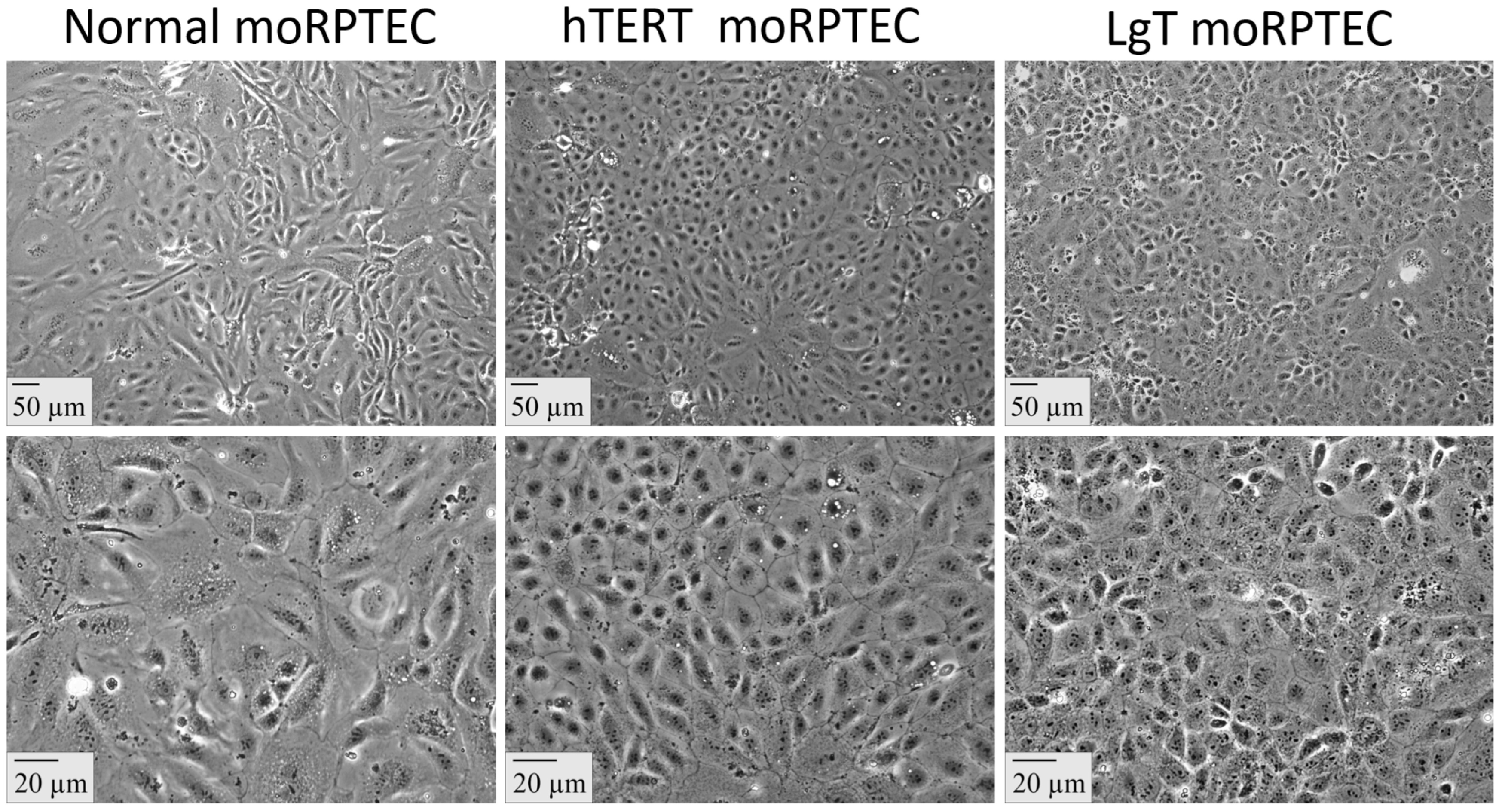
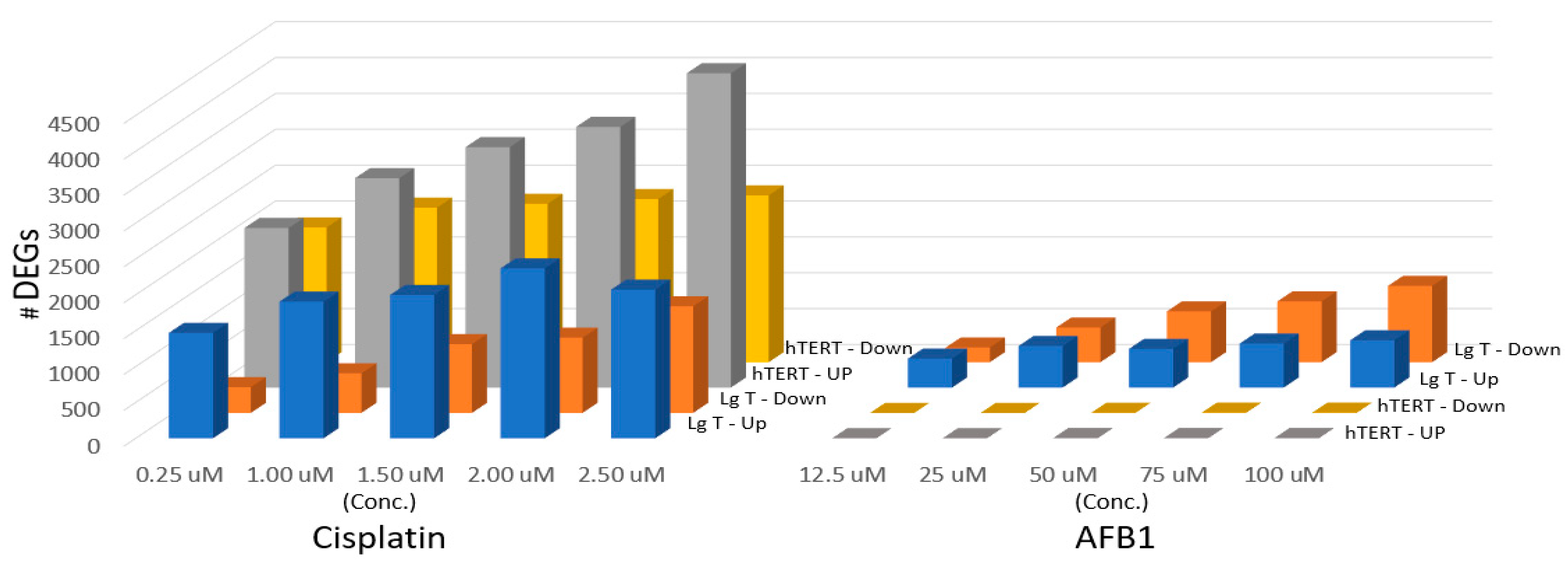
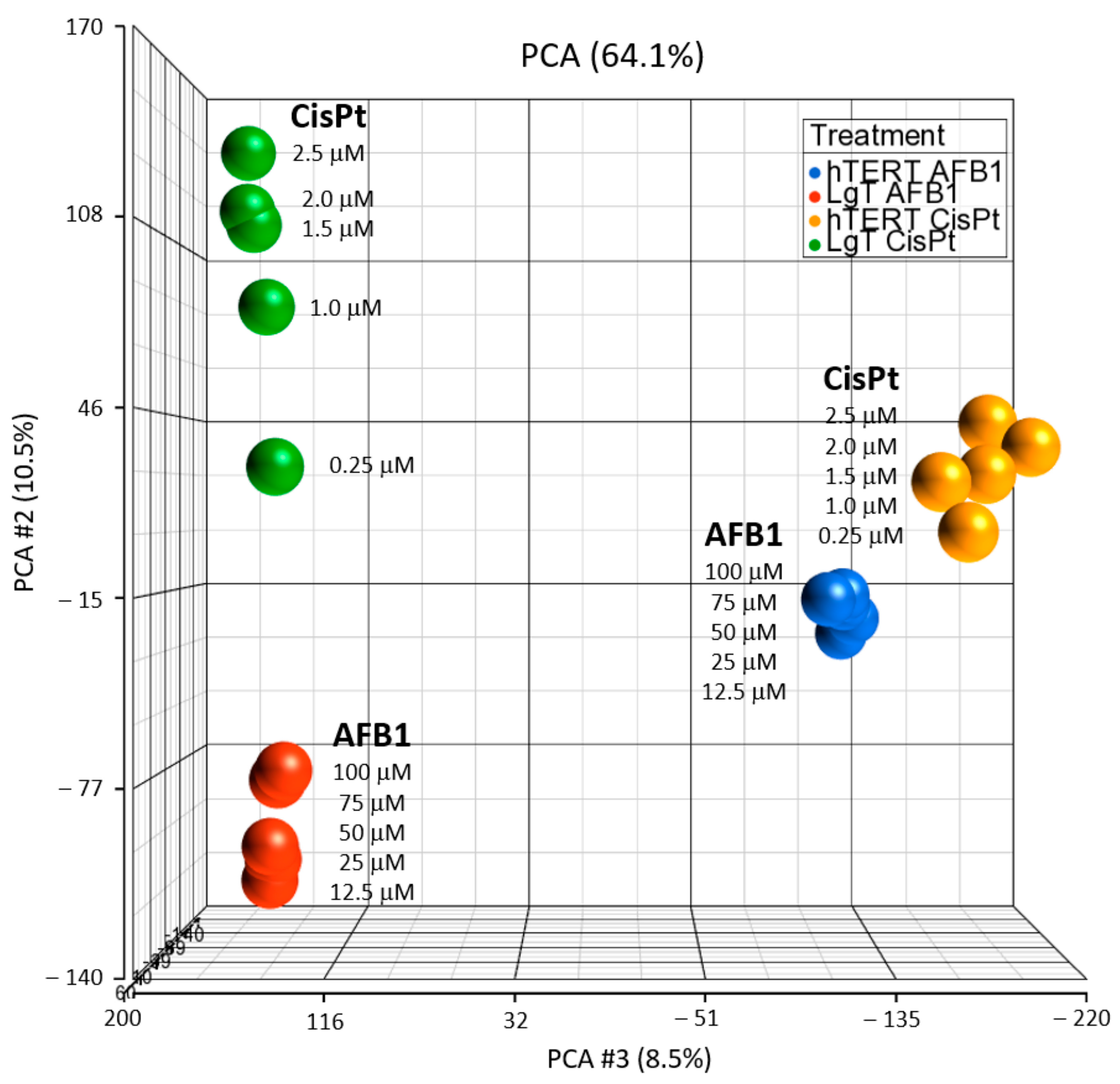
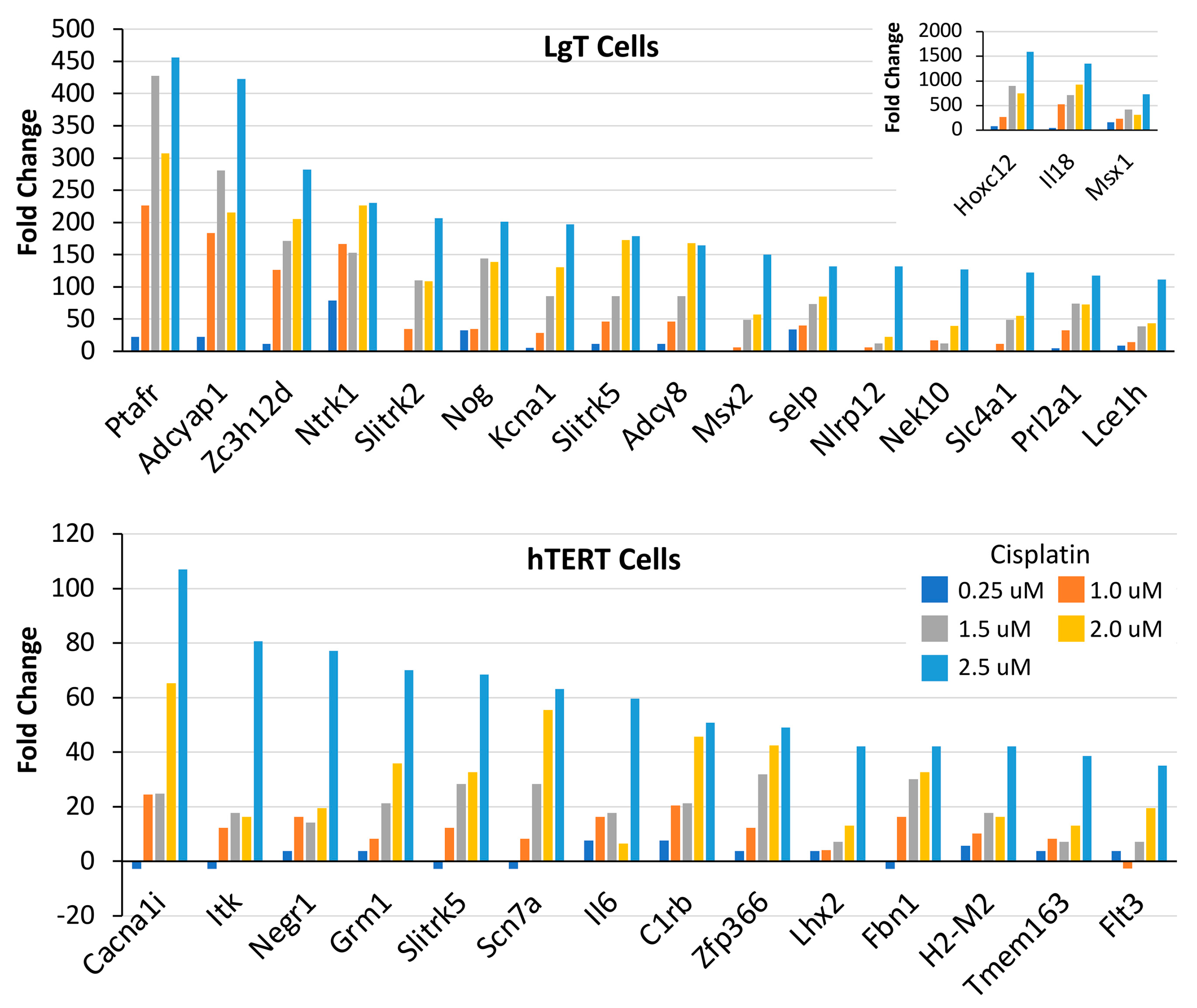
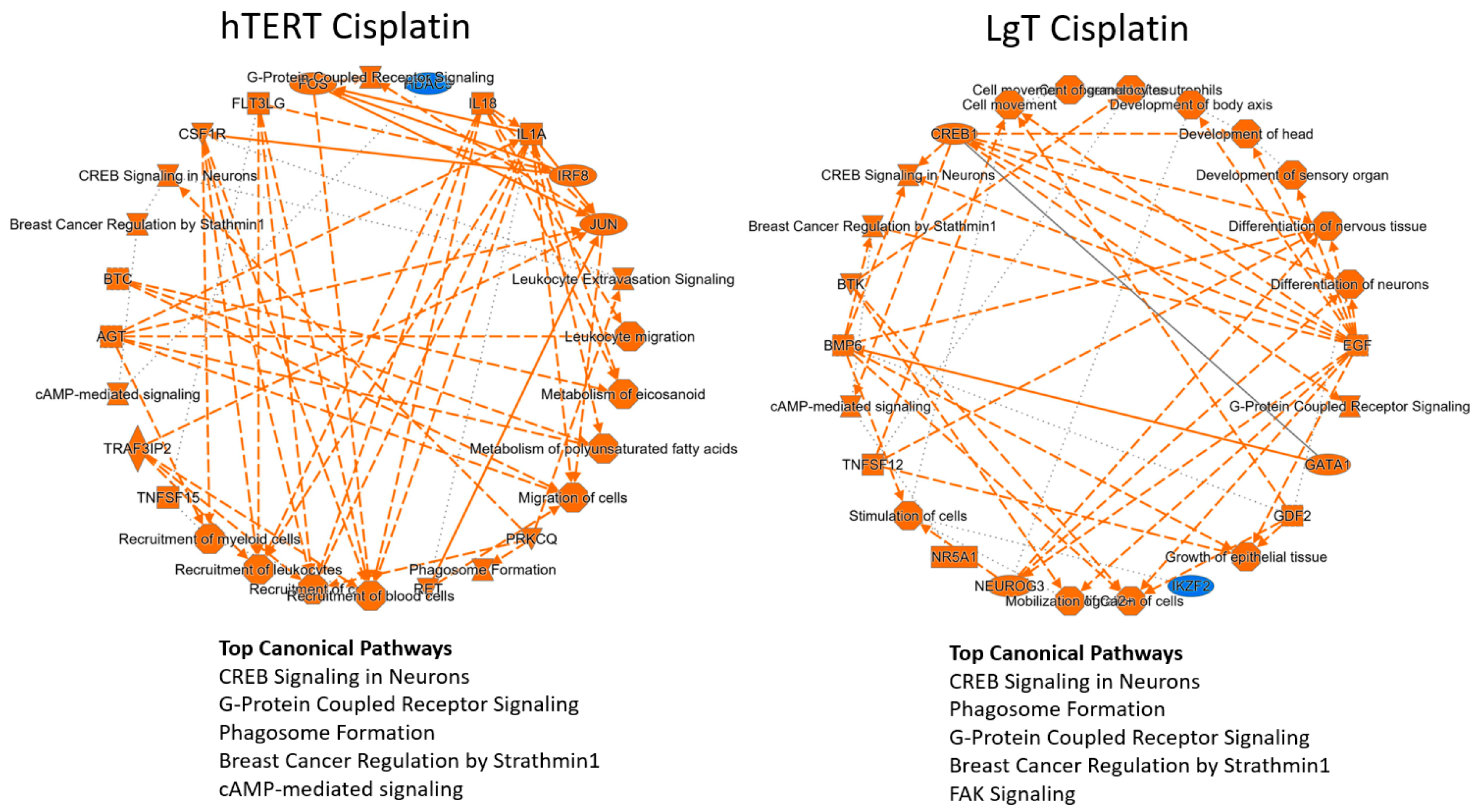
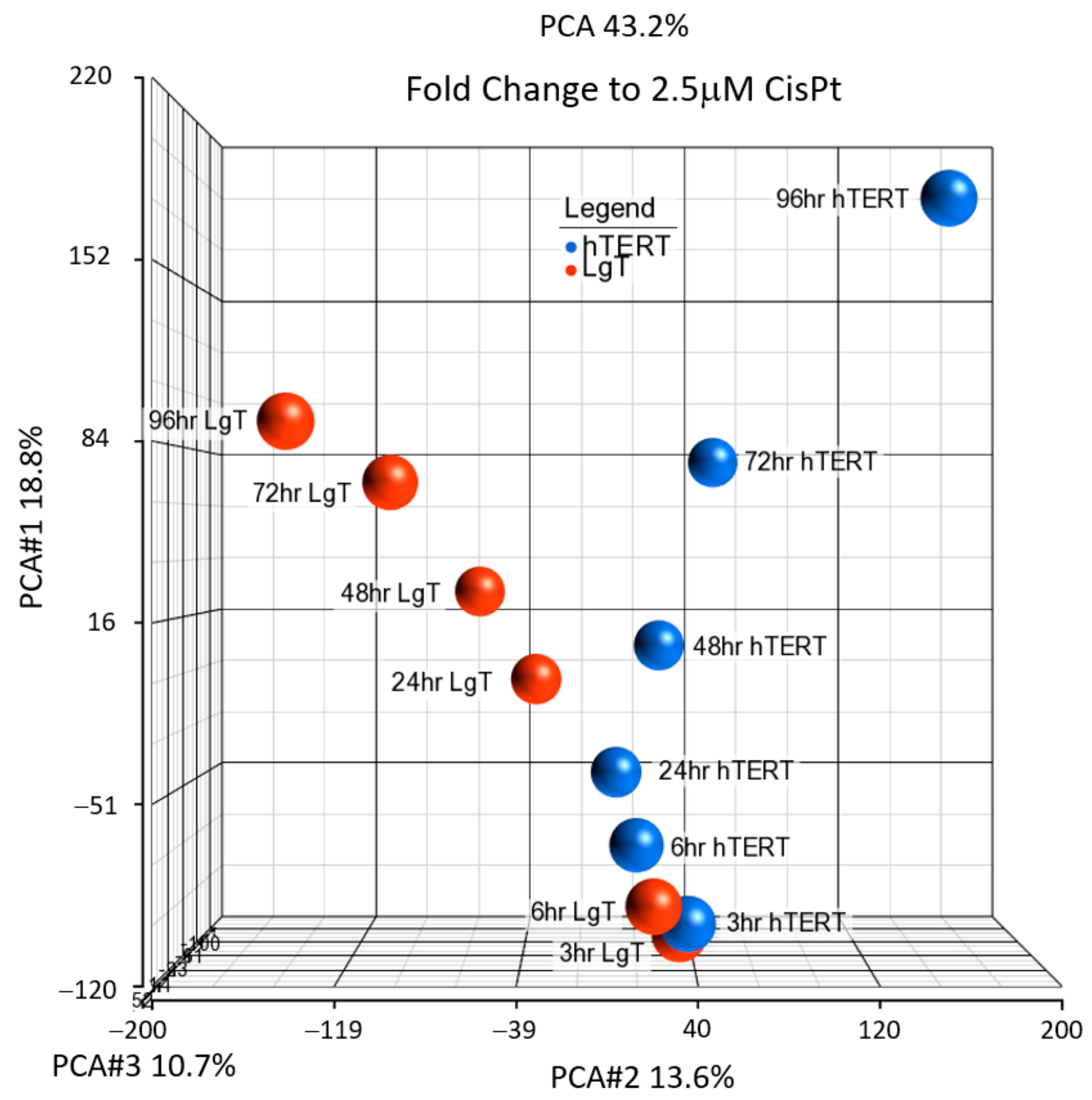
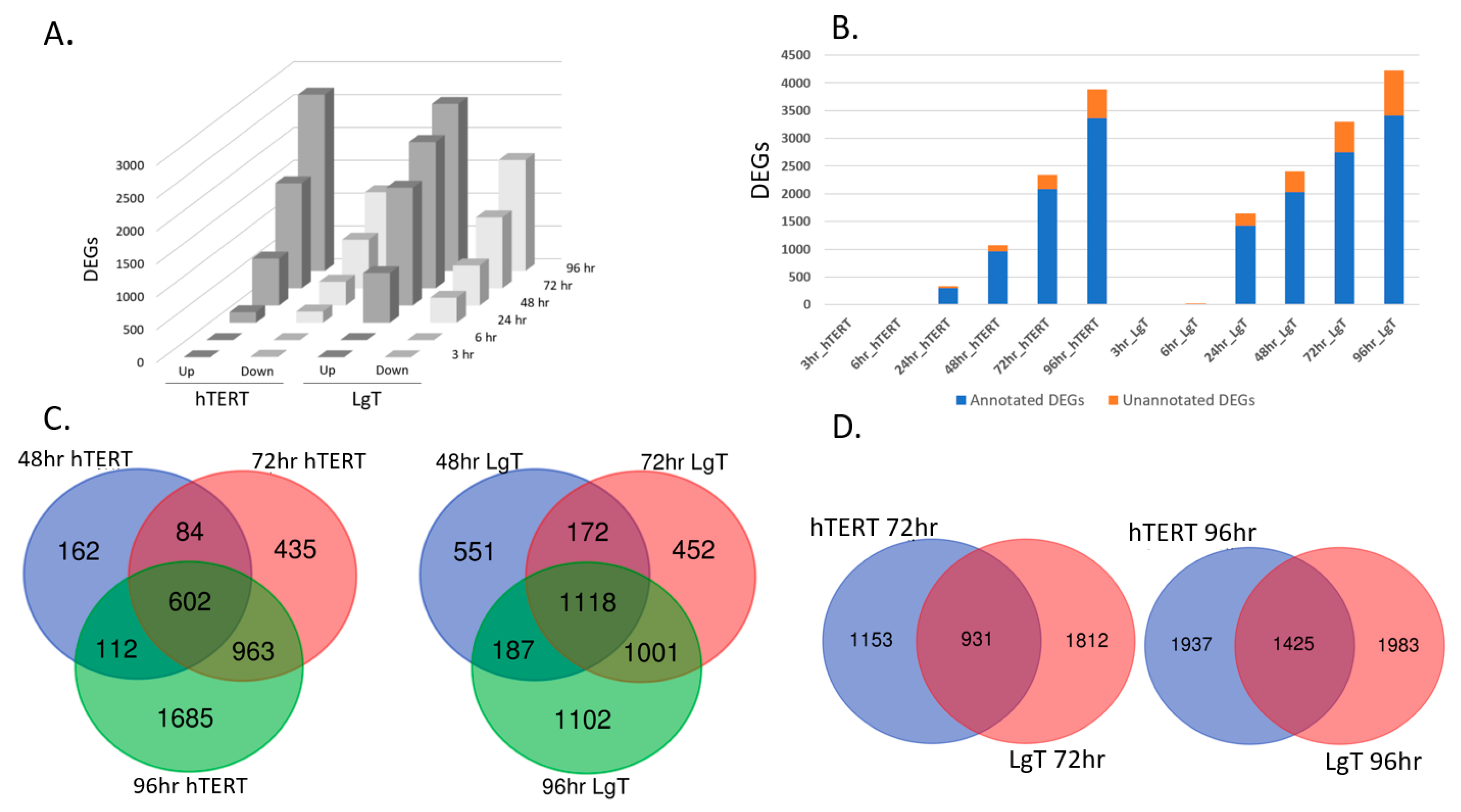

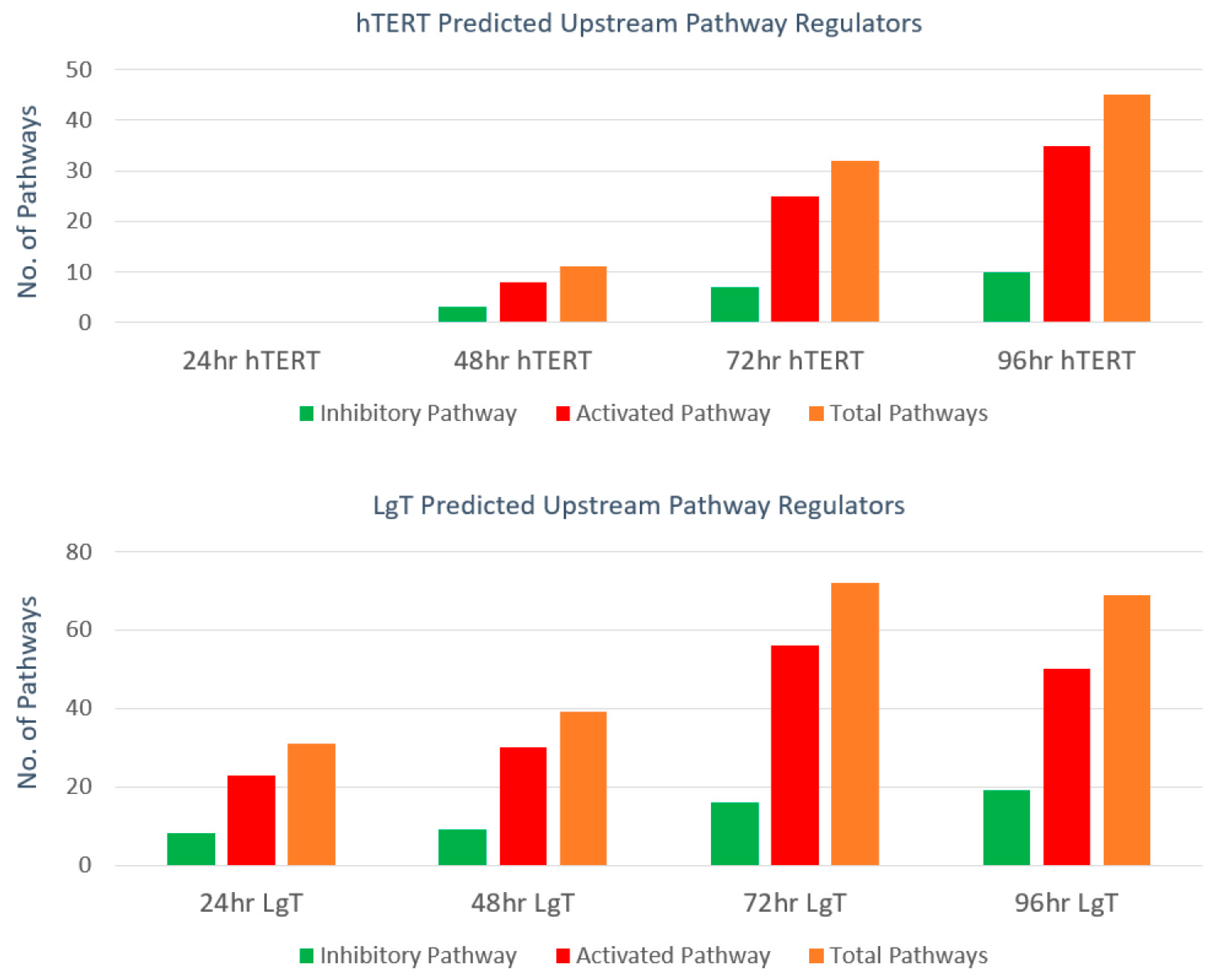
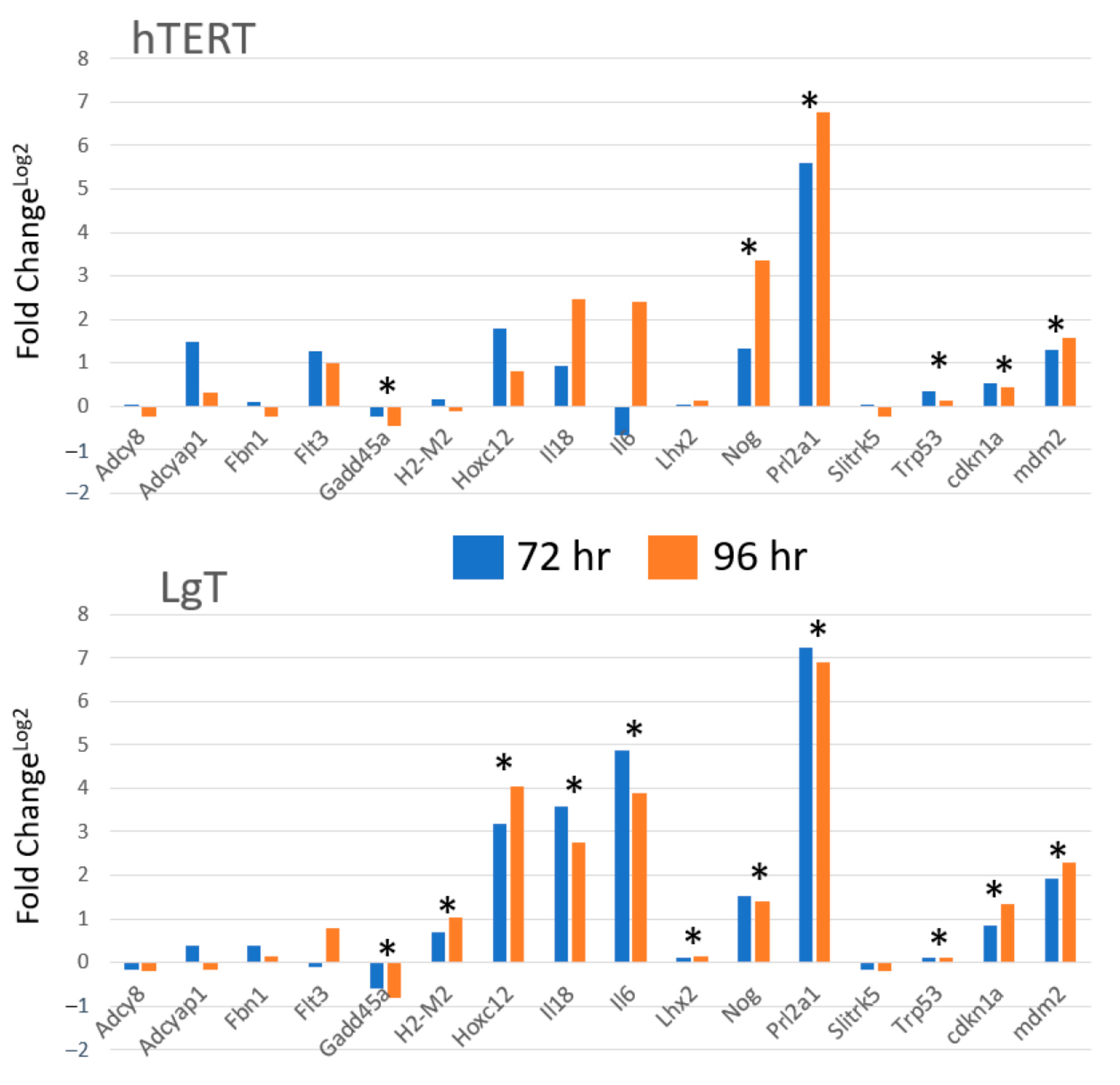
| Gene SYMBOL | 24 h FC LgT | Gene SYMBOL | 48 h FC LgT | Gene SYMBOL | 72 h FC LgT | Gene SYMBOL | 96 h FC LgT |
|---|---|---|---|---|---|---|---|
| Shisal2b | 279.9 | Smim43 | 222.6 | Exoc3l2 | 231.6 | Ccdc184 | 217.7 |
| Sult1b1 | 261.7 | Abo | 189.0 | Neurog2 | 145.9 | Dynap | 194.1 |
| Pla2g2f | 249.1 | Otof | 134.3 | Gm10634 | 145.7 | Myh3 | 184.5 |
| Hephl1 | 239.6 | Cbln2 | 133.1 | Shisal2b | 140.4 | Kcnd3 | 183.4 |
| Rfx6 | 235.8 | Robo4 | 114.3 | Serpinb2 | 129.5 | Nefl | 101.9 |
| Lhfpl1 | 223.9 | Sparcl1 | 102.2 | Ces2b | 127.9 | Mpped1 | 91.1 |
| Gpr55 | 220.0 | Lypd5 | 101.0 | Pnliprp2 | 127.7 | Lhx3 | 87.2 |
| R3hdml | 191.9 | Gal | 99.8 | Stc1 | 121.6 | Ptgs2os2 | 86.4 |
| Wfikkn2 | 149.8 | Col22a1 | 97.7 | Tlr13 | 119.2 | Acp4 | 80.2 |
| Eef1a2 | 137.8 | Tnnc2 | 94.9 | Syt5 | 115.5 | Chrna2 | 78.6 |
| Ces2f | 134.6 | Gpr158 | 89.0 | Nkx1-1 | 115.4 | Jph2 | 76.4 |
| Col6a3 | 127.5 | Hephl1 | 87.3 | Kprp | 103.0 | Il2rb | 73.0 |
| Sec14l3 | 125.5 | Gm32742 | 78.8 | Egr4 | 99.5 | Mybpc1 | 70.7 |
| Gsx1 | 121.5 | Slc13a3 | 77.9 | Dynap | 99.3 | Ifna13 | 70.3 |
| Cnr2 | 109.6 | Pramel16 | 75.7 | Astl | 92.9 | Nfam1 | 70.3 |
| Scn4b | 105.9 | Plxna4 | 74.4 | Btnl10 | 92.6 | Il10ra | 69.2 |
| Saa4 | 94.9 | Hba-a1 | 74.3 | Hhatl | 92.5 | Rab9b | 68.3 |
| Nme8 | 94.5 | Pnpla1 | 74.3 | Spta1 | 85.1 | Krt90 | 68.1 |
| Slitrk5 | 90.9 | Ctsq | 74.1 | Abo | 78.5 | Ric3 | 66.3 |
| Gm13652 | 89.0 | Ces2e | 72.1 | Xirp2 | 78.0 | Gast | 65.4 |
| Gene SYMBOL | 24 h FC hTERT | Gene SYMBOL | 48 h FC hTERT | Gene SYMBOL | 72 h FC hTERT | Gene SYMBOL | 96 h FC hTERT |
| Abo | 8.9 | Cacna1h | 178.3 | Otof | 239.0 | Tenm3 | 287.9 |
| Ces2e | 7.5 | Ctsq | 143.4 | Ikzf3 | 129.4 | Atp2b2 | 276.8 |
| Apol8 | 6.4 | Pla2g2f | 123.4 | Unc5a | 119.1 | Kcnn3 | 270.8 |
| Cyyr1 | 6.3 | Shisa2 | 109.6 | Aox4 | 114.2 | Abcc9 | 220.1 |
| Spon2 | 5.9 | Aknad1 | 95.7 | Trim9 | 111.3 | Otogl | 205.6 |
| Gm5737 | 5.9 | Prss42 | 92.4 | Mylk4 | 111.2 | Mpped1 | 198.9 |
| Des | 5.8 | Fam180a | 86.5 | Nyap2 | 111.0 | Chrm3 | 185.7 |
| Ces2f | 5.7 | Krt17 | 84.3 | Calm4 | 110.4 | Fibcd1 | 182.8 |
| Inpp5d | 5.5 | Prss2 | 79.0 | Cacna2d2 | 109.9 | Sema5b | 182.6 |
| Exoc3l2 | 5.4 | Adcyap1r1 | 71.0 | Adamtsl3 | 109.1 | Wdfy4 | 178.2 |
| Ces2g | 5.3 | Cbln2 | 67.6 | Mpped1 | 109.0 | Cacna1s | 176.0 |
| Scn4b | 5.2 | Pmfbp1 | 66.7 | Nppc | 106.6 | Trgc4 | 174.2 |
| Gm7607 | 5.1 | Otogl | 64.8 | Begain | 104.8 | Sparcl1 | 171.5 |
| Ascl2 | 4.9 | Nxph1 | 64.7 | Prkcq | 104.4 | Ikzf3 | 170.3 |
| Duox1 | 4.8 | Nyap2 | 64.1 | Pax7 | 104.1 | Pde11a | 169.4 |
| 2010310C07Rik | 4.7 | Colec10 | 59.4 | Hpse2 | 103.6 | Bank1 | 167.5 |
| Podn | 4.6 | Rasgef1c | 59.3 | Slc5a4b | 101.7 | Sez6l | 158.0 |
| Zfp541 | 4.5 | Vwa3b | 51.5 | Sv2c | 100.8 | Krtap3-2 | 157.6 |
| Hic1 | 4.3 | Kif28 | 51.5 | Dsc1 | 100.7 | Gabbr2 | 154.6 |
| Fam83e | 4.2 | Foxl1 | 51.1 | Dock2 | 100.5 | Slc5a4b | 154.4 |
| Gene SYMBOL | 24 h FC LgT | Gene SYMBOL | 48 h FC LgT | Gene SYMBOL | 72 h FC LgT | Gene SYMBOL | 96 h FC LgT |
|---|---|---|---|---|---|---|---|
| Enox1 | −9.7 | Elmo1 | −12.9 | Naaladl2 | −20.0 | Pacrg | −38.1 |
| Cdh13 | −10.0 | Vrtn | −13.2 | A830018L16Rik | −20.9 | Clstn2 | −42.8 |
| Kirrel3 | −10.8 | Inpp4b | −13.6 | Pcdhb9 | −22.4 | Syndig1 | −44.5 |
| Plcb1 | −10.9 | Pacrg | −13.8 | AAdacl4fm3 | −22.6 | Naaladl2 | −45.4 |
| Aff3 | −11.7 | Stk32a | −14.4 | Aadacl4fm5 | −24.0 | St6galnac3 | −46.0 |
| Afm | −11.7 | Slc9a9 | −14.4 | Afm | −24.8 | Slc13a1 | −46.9 |
| Gpc6 | −12.4 | Clstn2 | −14.5 | St6galnac3 | −26.2 | Fhit | −55.2 |
| Sox5 | −12.4 | Msra | −14.6 | Clstn2 | −26.2 | Klhl14 | −56.5 |
| Ccdc178 | −12.8 | Plcb1 | −14.8 | Tenm4 | −26.3 | Pard3b | −57.1 |
| Slit3 | −13.2 | Aff2 | −16.6 | Pard3b | −26.5 | Agmo | −57.3 |
| Foxp2 | −13.4 | Gpc6 | −17.4 | Oog1 | −27.6 | Strit1 | −58.6 |
| Fhit | −14.4 | Gm31814 | −17.6 | Aoc1 | −29.5 | Sox5 | −64.4 |
| Tenm4 | −16.4 | Pard3b | −18.7 | Ptprq | −31.8 | Erbb4 | −71.7 |
| Ecrg4 | −17.8 | Sox6 | −20.8 | Gpr88 | −40.6 | Tenm4 | −76.2 |
| Plppr1 | −22.8 | Ostn | −20.9 | Dnajc5b | −42.1 | Aff2 | −76.4 |
| Gm31814 | −27.1 | Ntrk3 | −32.6 | 4930505A04Rik | −44.3 | Aoc1 | −100.9 |
| Taf7l | −35.6 | Gm24878 | −35.2 | Prr29 | −47.9 | Thsd7a | −110.5 |
| Tff2 | −37.4 | Tenm4 | −39.5 | Ostn | −53.6 | Dach1 | −150.9 |
| Kcnh8 | −37.8 | Fhit | −47.2 | Gm17783 | −62.8 | Dnajc5b | −157.2 |
| 1810013D15Rik | −41.3 | Ptprn2 | −97.3 | Fhit | −80.7 | Gm17783 | −270.1 |
| Gene SYMBOL | 24 h FC hTERT | Gene SYMBOL | 48 h FC hTERT | Gene SYMBOL | 72 FC hTERT | Gene SYMBOL | 96 h FC hTERT |
| Tln2 | −4.8 | Pacrg | −7.6 | D630024D03Rik | −10.4 | Pacrg | −22.7 |
| Tenm4 | −4.8 | Prkg1 | −7.7 | Acss1 | −10.8 | Cdh13 | −23.0 |
| Gabrb3 | −5.0 | Dnah11 | −7.8 | Cldn2 | −11.0 | Sox5 | −23.8 |
| Capn13 | −5.1 | Dab1 | −8.2 | Krtap1-5 | −11.0 | Npy2r | −24.9 |
| Pclo | −5.6 | Col5a2 | −8.8 | Gm13481 | −11.0 | Lrrc75b | −25.3 |
| Msra | −5.6 | Msra | −9.0 | Slc17a1 | −11.1 | Sema5a | −26.5 |
| Dcc | −5.9 | Fhit | −9.4 | Umod | −11.3 | Fhit | −27.1 |
| Sorcs1 | −6.4 | Gm47403 | −10.1 | A830018L16Rik | −11.4 | Ggt1 | −27.8 |
| Adgrl3 | −6.6 | Cyp24a1 | −10.7 | Lrg1 | −12.4 | Cdh16 | −30.0 |
| Plcb1 | −7.0 | Angpt1 | −11.1 | Esrrg | −12.5 | Fn3k | −30.3 |
| Fhit | −7.1 | Inpp4b | −11.6 | Pacrg | −13.4 | Gpc6 | −30.8 |
| Cyp24a1 | −7.1 | Thsd7b | −12.7 | Fhit | −13.9 | Sostdc1 | −32.2 |
| Cdh4 | −7.3 | Gpc6 | −13.9 | Gp6 | −16.5 | 4930426D05Rik | −33.3 |
| Inpp4b | −7.5 | Cfap299 | −14.3 | Immp2l | −16.7 | Immp2l | −33.6 |
| Esrrg | −7.7 | Cdh13 | −24.1 | Msra | −16.7 | Umod | −35.2 |
| Cdh13 | −7.8 | Immp2l | −26.0 | Cfap58 | −20.3 | Cldn2 | −37.2 |
| Gpc6 | −8.5 | Ccdc7b | −26.5 | Cdh13 | −27.6 | E130215H24Rik | −41.0 |
| Thsd7b | −9.6 | Spata22 | −33.3 | Gm22826 | −35.9 | 4933431G14Rik | −44.9 |
| Sox5 | −9.9 | Nobox | −40.6 | Zscan4d | −37.5 | A930003O13Rik | −49.1 |
| Immp2l | −10.1 | Egfl6 | −65.3 | Dnajc5b | −49.6 | Hsd3b3 | −58.6 |
Disclaimer/Publisher’s Note: The statements, opinions and data contained in all publications are solely those of the individual author(s) and contributor(s) and not of MDPI and/or the editor(s). MDPI and/or the editor(s) disclaim responsibility for any injury to people or property resulting from any ideas, methods, instructions or products referred to in the content. |
© 2023 by the authors. Licensee MDPI, Basel, Switzerland. This article is an open access article distributed under the terms and conditions of the Creative Commons Attribution (CC BY) license (https://creativecommons.org/licenses/by/4.0/).
Share and Cite
Merrick, B.A.; Martin, N.P.; Brooks, A.M.; Foley, J.F.; Dunlap, P.E.; Ramaiahgari, S.; Fannin, R.D.; Gerrish, K.E. Insights into Repeated Renal Injury Using RNA-Seq with Two New RPTEC Cell Lines. Int. J. Mol. Sci. 2023, 24, 14228. https://doi.org/10.3390/ijms241814228
Merrick BA, Martin NP, Brooks AM, Foley JF, Dunlap PE, Ramaiahgari S, Fannin RD, Gerrish KE. Insights into Repeated Renal Injury Using RNA-Seq with Two New RPTEC Cell Lines. International Journal of Molecular Sciences. 2023; 24(18):14228. https://doi.org/10.3390/ijms241814228
Chicago/Turabian StyleMerrick, B. Alex, Negin P. Martin, Ashley M. Brooks, Julie F. Foley, Paul E. Dunlap, Sreenivasa Ramaiahgari, Rick D. Fannin, and Kevin E. Gerrish. 2023. "Insights into Repeated Renal Injury Using RNA-Seq with Two New RPTEC Cell Lines" International Journal of Molecular Sciences 24, no. 18: 14228. https://doi.org/10.3390/ijms241814228
APA StyleMerrick, B. A., Martin, N. P., Brooks, A. M., Foley, J. F., Dunlap, P. E., Ramaiahgari, S., Fannin, R. D., & Gerrish, K. E. (2023). Insights into Repeated Renal Injury Using RNA-Seq with Two New RPTEC Cell Lines. International Journal of Molecular Sciences, 24(18), 14228. https://doi.org/10.3390/ijms241814228






